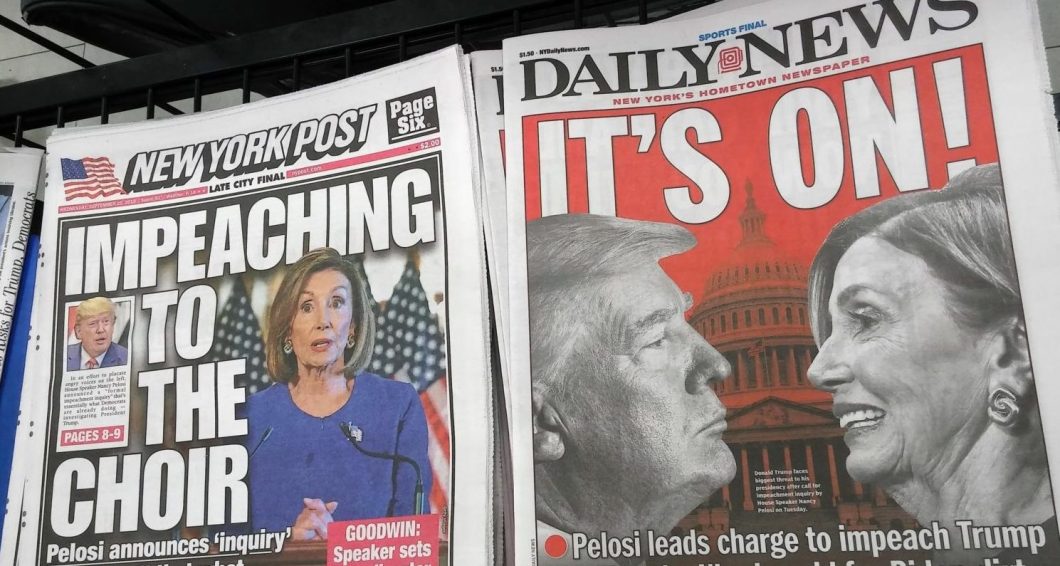The Chief Justice is a former clerk to Rehnquist, so we should look for him to tread lightly in his predecessor’s footsteps.
Supermajority Rules as a Check on Hyperpartisan Removals
It is a commonplace that we live in a hyperpartisan age. The latest example of this hyperpartisanship is the Democrats’ opening of an impeachment inquiry into President Donald Trump’s telephone conversation with the President of Ukraine. Having failed to generate sufficient support for an impeachment through the Mueller investigation, the Democrats have now announced an inquiry following the whisteblower complaint.
Yet, Republicans have so far largely stood by their President. There was virtually no Republican support for impeachment from the Mueller probe and little so far from the Ukraine phone call. In fact, Republicans have tended to see both investigations as reflecting the bad actions of Democrats, with the Mueller probe seen as an unjustified investigation that ended up being much ado about nothing and the Ukrainian matter seeming to be an effort by the deep state to once again sink the President.
The removal of a President for less than serious wrongdoing is one of the worst aspects of hyperpartisanship. We can therefore be thankful that it seems unlikely that the President will be removed from office unless there is some evidence of serious wrongdoing uncovered in the future. It is important, however, to recognize what in our system is protecting against a hyperpartisan removal. It is the supermajority rule in the Constitution that requires two-thirds of the Senate to vote for an impeachment conviction before an official can be removed. Without this supermajority rule, our politics would be very different and would be much more subject to the noxious forces of hyperpartisanship.
Even if the Democratic House secures the majority necessary to impeach President Trump, the President cannot removed without a two-thirds vote following a Senate impeachment trial. Given that the Republicans hold 53 seats in the Senate, the removal of the President would require that at least 20 Republican Senators join with all of the Democrats (and independents). This degree of bipartisanship is likely to occur only if evidence of gravely serious wrongdoing were to be uncovered.
By contrast, if a mere majority of the Senate was all that was needed for removal, the President would be in a far less secure position. It is certainly conceivable that four Republican Senators might shift their votes to convict the President even if there was no evidence of grave wrongdoing. But those four Senators might not even vote to remove under a two-thirds supermajority rule since their votes would not change the result.
Thus, the two-thirds supermajority rule operates to protect Presidents from removal in our age of partisanship. This effect of the supermajority rule is not only evident today, but was present during the impeachment of President Bill Clinton. Partisanship was also evident at that time as well. The Republican controlled House had impeached Clinton for both perjury and obstruction of justice. The Republicans, shamefully, held the impeachment vote during the lame duck session after the 1998 elections, because the number of Republicans would be reduced in the new Congress.
Yet, the impeachment was to no avail. The Senate did not vote to remove the President on either count. On the obstruction charge, the Senate voted 50 to 50, and on the perjury charge, it voted 45 to 55. At the time, it seemed obvious that the Senate would not remove the President and the trial was a limited affair. But had the removal required only a majority, it is very possible that President Clinton would have been removed.
The supermajority rule for removals is also important for another official with enormous power in our modern world—Supreme Court justices. Throughout American history, there have been movements to impeach and remove Supreme Court justices, including perhaps most famously Earl Warren.
The move to impeach Supreme Court justices started early on when the Jeffersonians sought in 1803 to impeach Supreme Court Justice Samuel Chase. While the House impeached Chase, the Senate refused to convict, with the closest vote against Chase being 18 for and 16 against removal. Thus, the supermajority rule protected Chase from being removed. This incident started a tradition in which it is generally thought that Supreme Court justices should not be impeached for their actions in office. The Court would not have the independence it now enjoys without the supermajority removal rule.
Significantly, Democrats have called for the impeachment of Justice Brett Kavanaugh on the grounds that he lied to the Senate about the Christine Blasey Ford allegations. While such a charge is unlikely to secure support from a substantial number of Republicans, there would be a real possibility of removal, especially when the Democrats control the Senate again, if the supermajority rule did not apply to the justices.
The supermajority removal rule has proved to be far more stable than other methods for combatting hyperpartisanship. Another way hyperpartisanship might be resisted is through the following of political norms. But those norms have proved to be too weak, and seem to be falling like dominoes. For example, norms involving presidential conduct have been regularly violated by President Trump, as have norms governing the investigation of presidential candidates and presidents. By contrast, the supermajority rule does not really rest on norms and the wise discretion of political leaders. It is merely a voting rule.
But supermajority rules are not perfect. While they work to protect Presidents and Supreme Court justices, they do not succeed as well in other situations. Another constitutional supermajority rule requires that treaties receive the assent not merely of the President but also of two-thirds of Senators. But Presidents have been able to circumvent this treaty supermajority rule by classifying their agreements with other countries under alternative categories, such as executive agreements or nonbinding agreements. For example, the Obama Administration defended the Iran nuclear deal as not requiring a two-thirds vote of the Senate on the grounds that it was not binding. Whether or not that was formally true, the agreement was treated by the Iranians as a binding treaty and certainly other countries appeared to rely upon it.
Although the Iran deal avoided the supermajority rule for treaties, it was not a full substitute for a treaty. A genuine treaty could not have been voided by the President alone (unless the terms of the treaty allowed for that.) Instead, voiding it would have required another treaty or a statute that conflicted with the treaty. Because the Iran agreement was not a binding treaty, the Trump administration was able to withdraw from it unilaterally. Thus, the attempt to circumvent the treaty rule had disadvantages for the Obama Administration. Still, circumventing the Treaty supermajority rule was arguably beneficial for the Obama Administration, since it allowed the Iran Deal to function for a limited period and it likely would have been continued had Hillary Clinton been elected.
While supermajority rules are not perfect and can sometimes be circumvented, the supermajority rule for removals has proved to be of significant value in protecting the independence of both Presidents and the Supreme Court justices. Few constitutional provisions have been as successful, and today this provision may be the only thing impeding even more intense partisanship concerning impeachment and removal.


